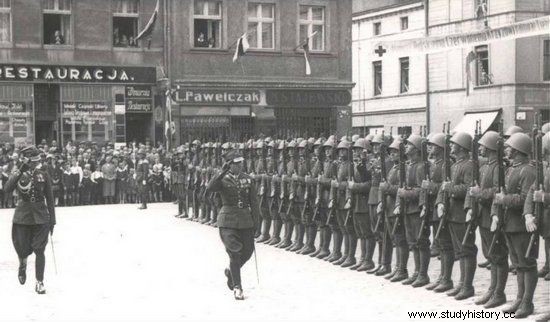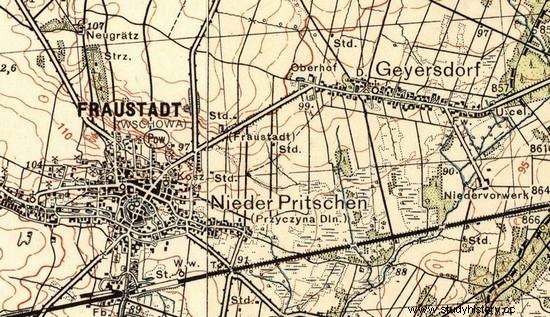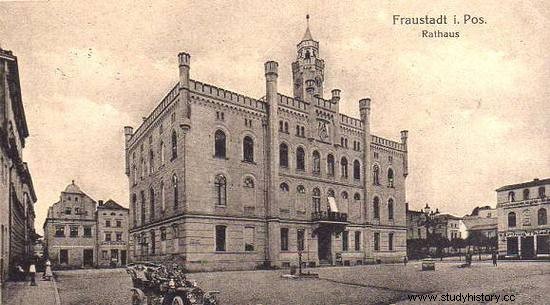Horror, panic and disbelief. Such feelings accompanied the inhabitants of the German border towns of Geyersdorf and Fraustadt, which were attacked on September 2, 1939 by units of the Polish Army.
With the German invasion of Poland on September 1, 1939, there was a relative peace in the zone of operations of the "Poznań" army in Greater Poland. In this section, mainly secondary units of the German Landwehr and Grenschutz operated, which did not put too much pressure on the Polish troops. The greatest enemy activity was recorded in the vicinity of Leszno, which at 5.15 was shelled by artillery fire.
Soon to Brig. Gen. responsible for the defense of this part of the border. Roman Abraham, commander of the Greater Poland Cavalry Brigade, numerous reports from units subordinate to him started to arrive. The Germans seized the towns of Bojanowo, Rydzyna and Rawicz.
German saboteurs also fired on the local garrison headquarters in Leszno (the command of the 55th Infantry Regiment was stationed here). The city was also struck by two enemy infantry battalions, but it was easily repelled by the Poles.
After a few hours, the Germans struck again, this time with the support of local Volksdeutsche. Due to the decisive attitude of the Polish soldiers, this attack was also unsuccessful. 16 saboteurs were killed and 19 were taken prisoner. The Nazis were also driven from the previously occupied towns.
General Abraham's bold plan
In view of the successful development of the situation, gen. Abraham, who had a reputation as an exceptionally energetic officer, decided to carry out an excursion into enemy territory. The Polish commander wanted to recognize what enemy forces his brigade had in front of him. It was also supposed to be a kind of retaliation for the attack on Leszno.

Review of the 55th Infantry Regiment on the market square in Leszno in 1938. It was the soldiers of this unit that had a reconnaissance mission on the territory of the Third Reich.
September 2, 1939 around At 2 p.m. Gen. Abraham gave the order to col. Władysław Wiecierzyński, the commander of the 55th Infantry Regiment assigned to him, to conduct a reconnaissance trip on the territory of the Third Reich towards the town of Fraustadt (now Wschowa). The regiment commander appoints the 2nd infantry company (3 infantry platoons) commanded by Cpt. Edmund Lesisz. The infantry was to be supported by an artillery platoon consisting of two 75 mm caliber guns, commanded by Capt. Ludwika Snitko, a platoon of heavy machine guns and a platoon of armored cars wz.34.
Forces of Capt. Lesisz were insured from the north by a cavalry platoon under the command of 2nd Lt. Tadeusz Strya. This small unit consisted of 35 lancers, a dozen cyclists acting as liaison officers, a machine gun on a wheelbarrow and a radio station.
The forces protecting the attack group from the south were led personally by General Roman Abraham. They included a squadron of TK-3 tankettes of lieutenant Wacław Chłopik and a platoon of cyclists of lieutenant Zbigniew Barański. The whole thing was insured by motorcycles with erkaems.
The starting position for the attack on German territory was the village of Stare Dlugie. There, Polish infantry soldiers were dropped off by buses. Unfortunately, the armored cars and artillery were late. Nevertheless, Capt. Lesisz did not wait. Around 17.30 gave the command to attack.
Border fight
The 1st platoon of the 2nd company under the command of Lieutenant Stanisław Rybczyński attacked the border crossing under the village of Geyersdorf (now Dębowa Łęka). In the meantime, the 2nd platoon of Lieutenant Władysław Konwiński storms the Grenschutz watchtower.
The shooters break into line and strike. They have to travel about 300–400 meters of open space. The watchtower crew greets them with fire. Suddenly, a German motorcycle patrol shows up unexpectedly. There is a short but violent shooting. The Germans suddenly stop shooting. The motorcyclists retreat, and with them in a truck, in a cloud of dust, the outpost crew runs away.

Staff map with marked Geyersdorf and Fraustadt, which became the target of the Polish attack on September 2, 1939,
The situation clears up after a while, when on the other side of the building you can hear a hurricane fire and a thunderous "hooray". This is the rest of the company moving towards Geyersdorf. Now the Poles are quickly seizing the watchtower. Apart from a few corpses of defenders, significant amounts of weapons and ammunition were found in it.
After this short skirmish, the 2nd company advances with all its strength towards the village of Geyersdorf. The 3rd platoon of 2nd Lt. Stefan Perkiewicz. In the end, armored cars and artillery also arrived, but anti-tank ditches prevented them from crossing the border.
The guns take positions on the Polish side and open fire towards the village, where German soldiers and armed civilians are walking among the buildings. Seeing Polish soldiers, they fire machine guns at them from a distance.

Town halls in Fraustadt (Wschowa). After the capture of Geyersdorf, this town was fired upon by Polish artillery in retaliation against the German attack on Leszno.
"Blitzkrieg" in Polish
At the time of the infantry assault, Cpt. Lesisz on Geyersdorf, the protection group of general Abraham also joins the action. He later recalled:
Tanks from one platoon rush into the countryside, their movement shielding the other platoon with fire when stationary. Soon the buildings and stacks of cereals burn. In the next several minutes, after a short exchange of shots, the tanks, followed by motorcyclists and cyclists, enter the village. Geyersdorf welcomes us with silence. The people hid in houses and only where the barns are burning do the peasants wandering around saving them.
In this combined attack of infantry and combat vehicles, the village is quickly conquered and Polish soldiers watch with satisfaction as the Germans flee towards the Fraustadt.
As cyclists scoured the village, they took a dozen prisoners, frightened Grenzwach soldiers, seven of whom were wounded. After securing the village, the Poles are ready for the next jump. Gen. Abraham recognizes, however, that the primary goal of the action has been fulfilled. A reconnaissance was carried out and it was found that his brigade was not in any danger from this direction. A red rocket has been launched as a signal to retreat.
Artillery rematch
There is still the second part of the task to complete. The guns of Cpt. Snitki. In return for the artillery fire of Leszno and attacks by saboteurs, they are to fire on the Fraustadt, about five kilometers away. Snitko takes an observation post in a multi-storey school located on the edge of the captured village. The roofs of the German town were perfectly visible above the forest surrounding Geyersdorf. Telephonists efficiently pull the cable connecting the captain with his gunners.
A few minutes after 6.00 p.m., the Polish guns thundered. A total of 36 missiles were fired. The damage wasn't too big. Most missiles fell near the barracks. Several people died. However, the psychological effect of the fire was staggering. Chaos reigned in the city. The army began to withdraw, and the city authorities bombarded the garrison in nearby Glogau (i.e. the present-day Polish Głogów) with telephones, asking for help. Soon the road connecting the two cities was swarming with refugees. The city authorities also took their feet by the belt.
The soldiers of the 3rd platoon, 2nd Lt. Perkiewicz. In the heat of battle, Polish walkers missed the signal of the red rocket and reached a distance of one kilometer from the city. Only the prevailing silence made the commander realize that the action had to end and the soldiers withdrew.

Święciechowa village. It was the local Volksdeans who experienced an unpleasant surprise, confusing the unit of Second Lieutenant. Stryi with the Wehrmacht. Photo taken in 1942
A "heartfelt" greeting
The longest operating unit in Germany was the group of Second Lieutenant Stryi. This branch participated in the action for over 30 hours. While he was retreating, a little surprise awaited him. Returning to Leszno by a side road through the village of Święciechowa, located on the Polish side of the border, the soldiers were greeted by local Germans with banners and Nazi flags. The Germans were quite shocked when they saw what kind of army they were dealing with. Shots were fired and some of the more ferocious demonstrators were arrested and returned to Leszno.
The trip to Wschowa was only an episode of the Polish campaign of 1939. Its significance in operational or even tactical terms was negligible, as it had no impact on the general position of the "Poznań" Army or the Greater Poland Cavalry Brigade. He proved, however, that it was possible to fight the Germans effectively and, under favorable circumstances, to transfer activities to their territory, and with the involvement of sufficiently large forces, even to attempt to achieve greater successes.
